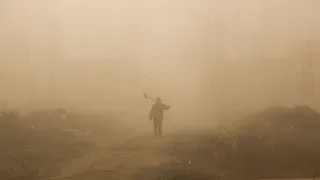May 23, 2016
Sequence Six: Field Notes of an Extrasolar Anthropologist
Kilian Melloy READ TIME: 10 MIN.
Kronom 1:
Our cadre achieved safe arrival last night. Local time is 36.87 orbitals since the last expedition. The research focus of the current investigation will be on the surge in electronics technology with an auditrom to detecting any initial research into transphasic materials or transphasic technical acquisition.
Initial planetary state at beginning of this, Expedition 720 to Galactic Coordinates 686 by 422 by 3112: Increase by 48 per dodon in atmospheric contaminants, including radioactive particles and persistent ozone debonding chemicals; steady rise in gaseous solar energy absorptive compounds; acidification of water masses; no discernible second level landmass management or large scale planetary engineering. Overall population increase continues to follow the Grothal Gatis projection.
Contrary previous visitations, preliminary monitoring indicates an overall decline in Sessevol Civilization Index rankings, particularly in politically preeminent nations. Despite considerable scientific advances, literacy has fallen, cuticle thinking skills appear diminished, social stability has decreased, and economic saturation has either flattened or reversed. Exact calibrations and reassessments of these monitoring study components will be undertaken as scheduled, though the likely outcomes appear almost certain to contradict expectations formed between this visitation and the last.
Initial conclusion: The global culture's perilous modes of conduct have not been ameliorated, while previously benign social, economic, and technological areas have now become sources of existential threat. These factors place the planet's governmental institutions overall on an accelerating path toward catastrophic collapse. Estimated crisis point in 42 local orbitals, with >.24 error margin, excluding chance interventions or a deliberate program of rehabilitation offered by a functional civilization.
Kronom 6:
Preparatory to refined sociological observations, the crew have begun assessment of pathogen and pollutant factors. After preparatory tests on livestock to establish an updated baselines for contamination levels in living tissue, we are ready to resume live testing on Tier One specimens from the local primary species. One such specimen resides in the immediate vicinity, Subject J-4088, tagged as Mardan. Preliminary observations at a distance confirm Mardan's continued residence in his ancestral home. Remote measurements and metabolic readings indicate aberrant development. Mardan's current age is 48 local orbitals but his stature remains that of an early- to mid-adolescent. His mother appears both larger and stronger than himself. Initial metabolic scan results show no indication of degenerative health conditions. When last tested at age 6 LO, a phenotypic projection suggested Mardan would develop into a much taller and more muscular example of his species.
Kronom 15:
Environmental and secondary species sampling procedures are now complete. Follow-up live testing on Mardan will take place in six local rotas. In the interim, social overview research has been re-initiated.
Kronom 16:
Social overview monitoring and interpretation continues, but several early results provide string insights. Despite substantial progress in information processing and personal electronic tools and accessories, fundamental research appears to have fallen into stasis. Additionally, individual capacities for problem solving, cooperative work, conflict resolution, social cohesion, and constructive initiative seem to have retrogressed. Initial studies conducted seventy two local orbitals ago ascertained cognitive levels averaging six on the Thlajjal scale, with social cohesion indices ranging across cultures from three to five on the Moljat Graph. Current rough preliminary findings indicate that cognitive levels have receded to an approximate measure of four, with social cohesion globally flattening to 3 or lower. Causes: Uncertain. Effect: Factoring these findings into the previously established volume of research suggests that global catastrophe could be approaching far more rapidly than earlier estimates. The acceleration curve toward crisis point and probable species failure has steepened significantly. Probability is low that the local predominant species will acquire transphasic technology.
Kronom 19:
The standard protocol for live testing with regard to Mardan (subject J-4088) proceeded normally until quick results from gastric channel biome survey indicated systemic metabolic and body chemistry upset not attributable to catalogued environmental circumstances. In the interest of more comprehensive diagnostic procedure, the study team subjected Mardan to holofield resonance scanning and discovered a secondary interdependent organism embedded in his system. The organism is developmentally complete, resembling local fauna type 8F-3647 (locally known as soft shell crab), but somewhat smaller. The organism, though phenotypically well established and capable of independent life function, appeared to have adapted to sustain itself on Mardan's physiognomic processes - the characteristic operative profile of a parasitic organism.
Kronom 21:
The local peacekeeping forces have become aware of Mardan's absence from his home. Presumably, his mother alerted them after our cadre declined to return him following initial testing. The subject has been kept isolated while our investigations continue.
Our initial operating hypothesis was that the secondary organism is common to the dominant species, to which we have subjected serious lower-level field exams. We adopted the theory that earlier missions had simply overlooked the secondary organism, or its presence is perhaps restricted to elite members of the species, with Marden being the first such individual to undergo our more intensive scrutiny.
However, test results conclusively disprove this theory. Micrometabolic and molecular life chemistry tests show definitively that the secondary organism, though well adapted to survival within the host body, did not co-evolve with the host organism. Not is the secondary organism responsible for the intellectual capacity of this planet's primary species. Rather than enhancing the subject's mental capabilities,m the parasitic organism seems to be dampening the host's ability for thought and reason. Molecular markers indicate that the parasitic being, in addition to not having co-evolved with he planet's dominant species, did not even evolve on this planet. The cadre's consensus is unanimous in concluding that the parasite we have discovered originated elsewhere in the galaxy, and is a recent arrival here. Our revised theory is now that the parasitic organism is linked in some respects to the observed decline in the species' intellectual acuity and social stability. Associated increases in aggression (social as well as individual) and ecologically degrading practices may also be linked to the parasites.
Using transtactic datastream communications, our exophysiology expert has conducted extensive literature research into our own history, with results cross-referenced to data gathered on the parasite we discovered living in Mardan's body. Initial results strongly correlate to fragmentary records from our own racial past. These incomplete records detail similar creatures found in the bodies of the dead in the wake of our own civilization's collapse, following a devastating epoch of resource consumption, environmental degradation, ecological mismanagement, and heightened political and police aggression.
The upheavals of our own history have cognates in the archaeological records of at least 78 known planets where higher order life forms have either become extinct or fallen from a certain level of technological sophistication into pre-technical modes of life. In many cases, the archaeological finds suggest a critical disjunct between technological mastery and evolutionary patterns of thoughts and behavior, leading to species self-destruction. In one-third of such cases, however, other factors seem to be involved. Academics have long theorized that outside influences could have played a role in planetary episodes of social collapse and massive mortality. Trace evidence in a further one-third of such cases points to a more widespread pattern of alien subversion and sabotage among emerging technological species.
In light of the parasite discovered to be living inside Marden's body, the cadre has formulated a new theory: That the secondary organism is an invasive species either evolved or engineered to drive its host species toward self-inflicted genocide. The experience of our own species in having survived the collapse of our earlier technological civilization would appear to be unique, as all defunct civilizations discovered thus far to which we may assign tenuous links to the parasites appear to have suffered complete negation and a complete perdotile of fatalities, meaning there were no survivors of the immediate aftereffects of cultural, economic, ecologic, and environmental collapse.
Preliminary genscan sequencing indicates that this organism may have been engineered, possibly as a weapon deployed by superior civilizations against less advances worlds. If this is the case, it means our native home world's collapse was the result of a deliberate strategy, with the goal of eradicating our species. It also means that the perpetrators are still in existence and employing similar techniques in a program of continued aggression. None of the known aggressive species, such as the Jaddek, the Riaa, or the Fyltomi are known to use genetically engineered parasitism. The Jaddek operate in classic military style, deploying ships and personnel in direct combat. The Riaa have been know to use bombardment against their enemies, redirecting asteroids and comets at the planetary homes of their opposition, but do not invest in life sciences research. The Fyltomi employ toxic compounds and, on occasion, broadly infectious exoplagues.
However, none of those species have been known to seek out and destroy emerging intelligence, nor have they been observed to plan and execute strategies that require multi-stage sequences and dohades of time, if not domuries.
Our investigations thus offer strong evidence that a silent, cunning, and malevolent species, heretofore unknown, lurks in regions of the galaxy previously thought to be well catalogued and understood, and continues to initiate and oversee clandestine genocidal operations within our own operational galactic zone of habitation and commerce. It is likely they operate outside this zone as well. At present, we have no way of knowing where the aggressor species may locate its home world or network of solar systems.
After scanning the immediate vicinity - up to 42 cubitarcs - we have discovered that approximately eight perdon of the local population are infested with the parasitic being. The cadre speculate that the perdonnage is much higher in the owning class than in the servitude class.
Kronom 23:
The secondary organism has removed itself from Mardan's body, tearing its way out of him without regard for his safety and fatally injuring him in the process. Though the examination chamber was secure, the organism cannot be located. I fear it may find a way to infest one of our cadre.
Kronom 27:
The parasitic organism is either highly intelligent and motivated on its own or it is being directed remotely by a controlling agency. The organism managed to evade detection or capture and to infest the cadre's transtactic communications specialist. She then somehow contacted a horde of parasitic organisms, which drove their hosts to converge in the field where our ship currently resides. The parasitic organisms then tore themselves free of their hosts.
Sesdons of local species members are now dead, their rent and shredded bodies scattered around our ship's location. Corresponding sesdons of parasitic organisms have besieged us, with the infested specialist securing their access to the ship's interior. It appears our defenses are of limited utility pagans the parasitic organisms, which are fully functional in the planetary environment at large. The research team and ship's crew have been scattered throughout the vessel, and reports indicate high casualty rates.
I have lost contact with the others and fear I may be the last survivor. I have had little success in my attempts to sabotage or destroy the ship to prevent the parasites from reaching the home worlds and launching a new campaign to destroy us from within. My last possible attempt will be to access the ships tholaras array and then
Kronom 30:
I audited the being's field notes as recorded here and then deleted them. Since sensory and memory functions all seem intact and language function is completely fluent, it appears that my colonization of its body and brain were successful. Similar successes have brought the majority of the beings into our sphere of influence, although both sides sustained a number of casualties on both sides. The losses were well within acceptable limits, and the local communal mind seems unimpaired. Not all of my compatriots managed the feat. Two of the grafts were incompletely successful; the hosts were ruined and the compatriots neurologically compromised. They had to be destroyed.
There are ten beings left, all grafted and contributing to the local communal mind. The being's amusing notations reveal a fear that our next target would be his home planet, a world our kind already crashed once in the distant past. He need not have worried: His species passed the test and, having done so, they are now racially inoculated against such frenzies of self-destruction. His precious planet Earth is secure. More than secure: Judging by this ship and his memories, my host would be pleased to understand that Earth and its dominant intelligence, humanity, will soon be accorded a suite of privileges and access to the accumulated wisdom of the galaxy's most accomplished races.
But this planet, called Auvissa by its inhabitants, is still in the first testing stage. The being's calculations agree with our own: This planet will crash in little more than a local decade. Then the secondary testing stage will commence. One third of all planets we test successfully resist our social and economic strategies; these innately healthy species we contact at once for membership in the High Alliance. The species that crash almost always go extinct, but three percent do survive the ensuing chaos and, eventually, rebuild. Of those who do survive, fewer still return their attentions to technological endeavors. Those who do typically achieve much higher levels of technical competence. When they attain high level technological status - transphasic technology, space transverse, matter reconfiguration, meaningful energy manipulation - they too are invited into the High Alliance. Those species that choose a non-technological path are allowed to eke out their existences undeterred and unaided.
The races we did not find and test before they achieved space transverse may, one day, stumble toward sufficient elevation to warrant inclusion in the High Alliance. If not, they will no doubt eradicate one another, or manage to destroy themselves.
Or perhaps we will one day devise a second testing level - and those space-faring races, too, will experience the winnowing effects of the crash protocol.
For now, the local commune must dedicate itself entirely to disposing of these humans and their non-Auvissi technology. The destruction or concealment of their biological and technological elements is only a fraction of the work we must accomplish in a short space of time. We have cover stories to devise -- cults to blame, economic castes to implicate, and variant individuals to cast as suspect in different ways and to different degrees, according to their physical differences and the intensity of social and legal opprobrium those variances provoke: Their number of manual digits, or their skin texture, or the refractive index of their eyes.
But the work will be most worth it for the results we anticipate. This mess will make for good kindling, as we feed the fires these immature primitives need to harden and develop into life forms both viable and worthy.
Kilian Melloy serves as EDGE Media Network's Associate Arts Editor and Staff Contributor. His professional memberships include the National Lesbian & Gay Journalists Association, the Boston Online Film Critics Association, The Gay and Lesbian Entertainment Critics Association, and the Boston Theater Critics Association's Elliot Norton Awards Committee.





